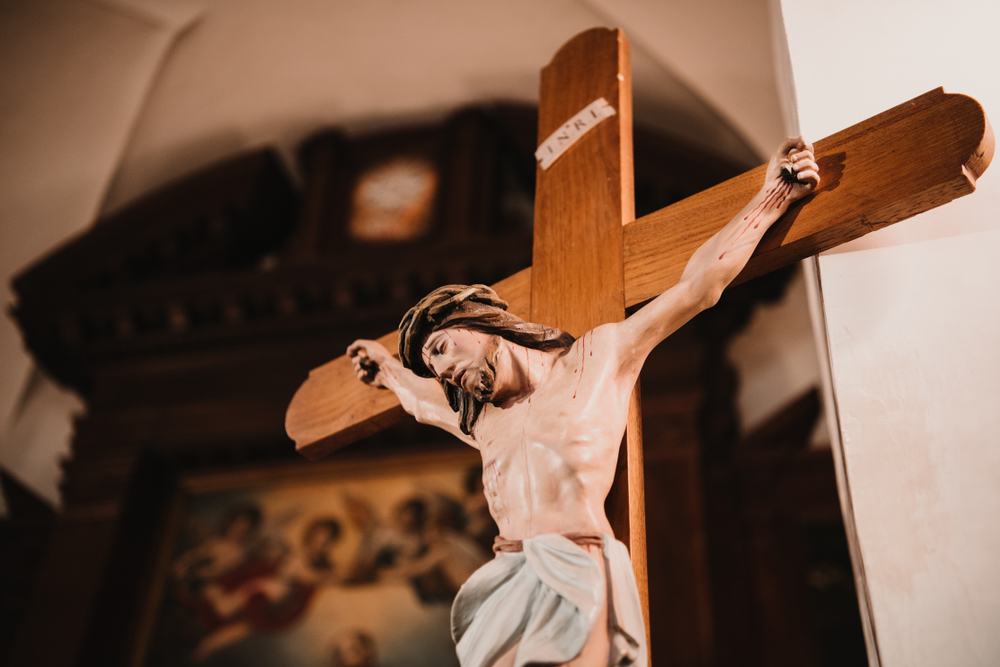Early Church history and tradition teaches that each day of the week has a theme which can help us to celebrate ordinary time. This day we remember the Passion of our Lord. This emphasis is so essential to Holy Mother Church that she asks us to make some sort of sacrifice on this day (even outside of Lent). Traditionally, abstinence from meat has been that sacrifice, but others may be more appropriate to your family. For instance: abstinence from sweets, TV, videos, or other forms of entertainment. Here’s a couple of other suggestions:
- Encourage the family to make a sacrifice together. First, decide if abstinence from meat is truly a sacrifice in your family. If not, decide on something that is.
- Encourage family members to make an additional sacrifice that is just between themselves and the Lord.
Make a Small Sacrifice
Today, make a small sacrifice, such as abstaining from meat or desserts. Pray one or all of the Sorrowful Mysteries after dinner. They are:
- Sorrowful Mysteries
- Agony in the Garden — Mark 14:32-36
- Scourging at the Pillar — John 18:28-38
- Crowning with Thorns — Mark 15:16-20
- Carrying of the Cross — John 19:12-17
- Crucifixion — Mt. 27:33-56; Mark 15:22-41; John 19:16-30
Recognize the Sacrifices of Others
On Fridays we remember how Christ sacrificed His life for us. There are many people here on earth who have sacrificed for us in imitation of Christ. Today would be a good day to recognize them. Write a letter to a grandparent, neighbor, or family friend, letting them know you have not forgotten their sacrifices. Invite them over for dinner if possible and say a special prayer in thanksgiving for them.
Religious Art Fair
You’ll need books containing religious art (for example, Faith and Life series student texts), and/or calendars, Christmas, or Easter cards; paper; markers, crayons, pencils, and/or paint; and a place to hang the finished product.
In the past, many artists have portrayed the Passion of Our Lord and other events of His life in paintings inspired by their own faith and prayers. Spend some time looking at and discussing various famous pieces of religious art. Decide whether to copy the style of the artist or the subject of the painting and then start drawing. Display the finished products in a prominent place and invite friends or relatives to view the art. The children can act as museum guides, explaining the different pictures and how they were inspired.
Bearing a Cross
In His passion and death Christ carried a cross for us, for our sins. He asks us to pick up our cross daily and walk with Him. Talk about the crosses we bear as children and parents. How can we carry them as Christ did? When do we allow others to help? Is complaining and whining part of bearing a cross? Using the directions from the Apostles Book (page 73), make a book that tells a true or fictional story about someone bearing a cross for Christ. Many saints have wonderful, real-world examples of crosses to bear: for example: death of spouse, rejection of family — St. Elizabeth Ann Seton; wayward child — St. Monica. (Resource: The Saints And Our Children, Mary Reed Newland, TAN.)
Study the Virtue of Fortitude
The moral virtues are acquired by human effort and are the fruit and seed of morally good acts. Four virtues play a key role and are thus called “cardinal” virtues. One is fortitude, which ensures firmness in difficulty and constancy in the pursuit of good (CCC 1804,1805, 1808). Over the next week discuss fortitude and try to practice this virtue. Dinner-time discussions each night with the children will help. Try to include examples of fortitude from real life or stories. (Try The Saints And Our Children, mentioned above.)
Review the Stations of the Cross Books
If you didn’t make them in Lent, now would be a good time. If you did, you can remake or refurbish the old ones.
You’ll need eight pieces of construction paper per book (any colors); yarn; markers and/or crayons; and a prayer book with responses for each station.
Fold all eight pieces of paper in half at once. Tie a piece of yarn around the fold to hold the pieces together. Close book and write “Stations of the Cross” on the front. On each page, draw a picture of the station and write the response or prayer to be said. Using the books, do the Stations of the Cross at a local church.
Stations of the Cross Trail
Build this trail in your backyard using the supplies listed.
- large pictures of each station, drawn yourself and covered with clear contact-paper
- 15 stakes to stick in the ground
- 14 spots in yard (can use front- and backyards)
- heavy-duty staples or tape
Attach pictures to the stakes with heavy duty staples or tape. The first one should mark the beginning of the trail and give instructions. Place the remainder in various spots throughout the yard, creating a meandering trail. When done, take the trail yourselves and pray the stations.
Abstain from Meat
Bev’s Secret Pancake Recipe
Ingredients:
- 2 c. flour
- 2 tbs. sugar
- 1 tsp. salt
- 2 tbs. baking powder
- 2 eggs
- 1½ c. milk
- ½ c. vegetable oil
- 1 tbs. cinnamon
(For “buttermilk” pancakes: add one tablespoon vinegar; substitute two teaspoons of baking powder for the two tablespoons; add one teaspoon of baking soda.)
Mix with all ingredients together with a fork. For best results, let wet ingredients stand at room temperature before mixing.
— Recipe compliments of the Grab family
Family Service Chart
You’ll need poster board and markers and/or crayons.
Make a list of household chores and assign each child one or more chores according to his or her age and ability. Write the names next to the chores on your chart. Use a pencil so that the chores can be changed periodically. Discuss how we sometimes need to sacrifice things we want in order to do the things we should. Christ gave His life to save us from our sins, we can imitate Him by giving our time for the good of our family.
Banishing Bickering
Meditating on the Stations of the Cross is most fruitful when it relates to our everyday lives. One example is the importance of silence, as in the silence on the part of Christ when He was condemned to death, when He was tormented by the soldiers, or when He fell under the weight of the cross. Bickering is one child’s tormenting of another child. The one who holds out the longest in pecking at the other is the perceived “winner.”
It might sound like this:
“You pig, you took the biggest.”
“I’m not a pig.”
“Yes, you are!”
“No, I’m not!” and so on. . . .
Silence can be the answer to this. If one of the children would just stop and remain silent in spite of the fact of the untruth of the other child’s words, just as Christ did in the face of the soldiers, the bickering stops. We can explain to children that this is difficult, but with Christ’s help and example we can do it. We can teach them Christ’s words: “Whatever you did for one of these least brothers of mine, you did for me” (Matthew 25:40, NAB). Remind them that provoking a sibling is provoking Jesus and remaining silent under provocation is to be silent with Jesus.
Reader’s Theater
Read aloud each Scripture reference. Split the parts up like a play so that everyone reads. (The entire passion is too long for one day, so we have split the reading over the next few Fridays.)
- Jesus condemned to death: Matthew 27:11-26
- Jesus accepts his cross: Mark 15:16-20
- Jesus falls the first time: Psalm 5
- Jesus meets his mother: Luke 2:25-35
- Simon helps Jesus: Matthew 27:32
- Veronica wipes the face of Jesus: Isaiah 53:4-5
- Jesus falls the second time: Acts 3:17-26
For best effect read in low light and dim to candles at the end. Spend some time in silence and finish by reading together John 11:25-26.
Make Pretzels
Ingredients:
- 1 tbs. honey or sugar
- 1½ c. lukewarm water
- 1 envelope active dry yeast
- 1 tsp. salt
- 4 c. flour
- coarse or kosher salt
- 1 egg, beaten
Add the honey to the water (100° to 110°); sprinkle in the yeast and stir until dissolved. Add one teaspoon salt. Blend in the flour, and knead the dough until smooth.
Cut the dough into pieces. Roll them into ropes and twist into pretzel shapes. You can make small pretzels with thin ropes or large ones with fat ropes, but remember that to cook at the same rate, each batch of pretzels needs to be all the same size.
Place the pretzels on lightly greased cookie sheets. Brush them with beaten egg. Sprinkle with coarse salt. Bake at 425° for 12 to 15 minutes, until the pretzels are golden brown.
— Recipe from A Continual Feast, Ignatius
Prayer — Hidden Treasure
The four ends of prayer can be remembered by this acronym: ACTS.
- A (adoration) — giving praise and honor to God.
- C (contrition) — repenting of our sin.
- T (thanksgiving) — giving thanks for all God gives to us.
- S (supplication) — asking for God’s help.
Read About the Fall
Together as a family, read Genesis 3:1-24. Discuss sin and how it separates us from God. You can also discuss original sin and how Baptism erases this, leaving only the consequence of original sin, which is called “concupiscence.” This simply refers to the tendency to do wrong and is something we need to fight. The children should be very familiar with that urge within them to do things they know are wrong. We can help them to fight this through prayer, discipline, and the development of the virtues. Read verses 14 and 15 again. God promises that the serpent (Satan) will be crushed by the seed of the woman. Who might this be? Review the Ten Commandments.



